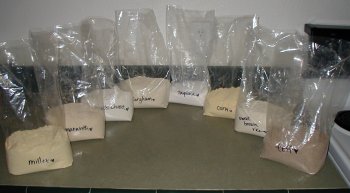I made that spelt and barley bread last week. A. couldn’t tolerate the barley bread. I knew she couldn’t have the spelt bread. We all are enjoying the spelt bread, and poor A. is dying for something she can eat.
So I am going to officially start experimenting with gluten-free sandwich breads. Thus far, my obstacle has been that all the recipes I have seen rely heavily on corn starch, potato starch and/or tapioca starch, actually incorporating very few whole grain flours.
I hope I can create something that will be nutritious and delicious.
I started today by grinding gluten-free flours.

The pictured gluten-free flours are: millet, amaranth, buckwheat, sorghum, tapioca, corn, sweet brown rice and teff. (I purchased the sorghum and corn already ground into flour for very good reasons.) Other grains I could have used/ground: other varieties of brown rice and quinoa. Dried beans such as garbanzo bean (chickpeas) and fava beans make gluten-free bean flour. And nuts and seeds ground up (such as flax seed meal or almond meal) can also be used in gluten-free baking.
Using my Vita-Mix on HIGH, I ground 2 cups of each of these grains for 30 seconds in the DRY container:
- buckwheat (hulled)
- amaranth
- teff
- millet
Using my Vita-Mix on HIGH, I ground 2 cups of this starch for 45 seconds in the DRY container:
- tapioca
Using my Vita-Mix on HIGH, I ground 2 cups of these grains for 1 minute in the DRY container:
- sorghum (however, I didn’t grind any of this today)
- sweet brown rice
I mixed 1 cup each of the tapioca, sorghum, buckwheat and sweet brown rice to make a gluten-free flour mix. I am going to testing various combinations of milder tasting flours for use as a nutritious but general flour mix.
I then made up a loaf of bread. I loosely modeled a recipe from “The Gluten-free Gourmet Cooks Comfort Foods” to create a loaf which used the general flour mix (above) in addition to teff, amaranth and millet flours. The loaf is in the oven now and smells great. I hope it will be! I will share more details about my experimentation later…
...without giving up the foods you love or spending all day in the kitchen!

2 free books:
Eat God's Way
Ditch the Standard American Diet, get healthier & happier, and save money on groceries...
We only recommend products and services we wholeheartedly endorse. This post may contain special links through which we earn a small commission if you make a purchase (though your price is the same).


Wardee,
I don’t know if you can use this or not, but I will tell you about it anyway. I sometimes use Dough Enhancer when making bread. The ingredients for the one I buy is as follows: whey (contains milk), lecithin, (soy), tofu powder, (soy), citric acid, dry yeast, sea salt, spice blend, cornstarch, ascorbic acid, natural flavor, no msg.
I haven’t looked at this ingredient list for a long time, so I am surprised to see soy in the ingredients. I am not a fan of soy, since most of it is gmo, and this one doesn’t list it as organic. I am sure there are many other brands out there, mayebe one that you could use. It “says” it makes fluffier baked goods, enhances natural flavor, and increases dough strength and shelf life.
Good luck!
Love, Tiffany
Thanks, Tiffany. You know I did use a dough enhancer yesterday. I made it myself from lecithin, Vitamin C crystals and ginger. I hope (but need to check) that the lecithin was organic/non-GMO. The bread turned out okay, not great. Have to keep trying!
Yesterday Pamela and I made some very awesome noodles you could experiment with some of these grains: GF/CF Hungarian Nockerl.
Tammy, those sound really good! Thanks for the link.
We have been doing gluten free baking for a while. The best blend I have found is 1 part sorghum, 1 part brown rice, 1/2 part potato starch, 1/2 part tapioca starch – then 1tsp xanthan per cup of flour.